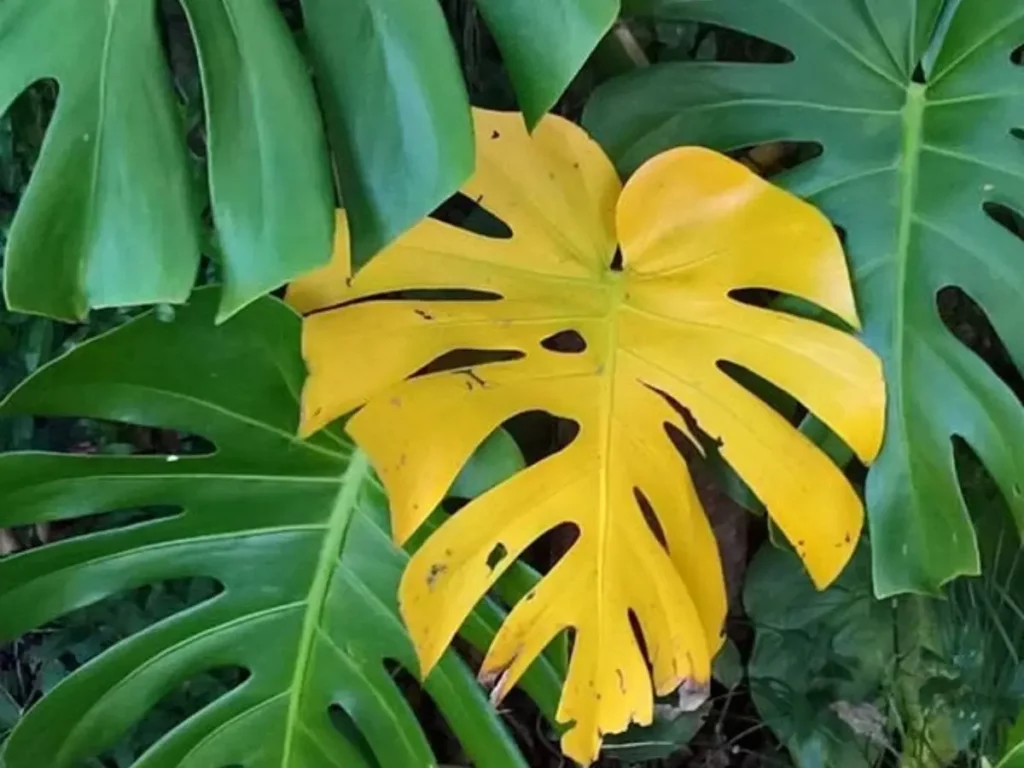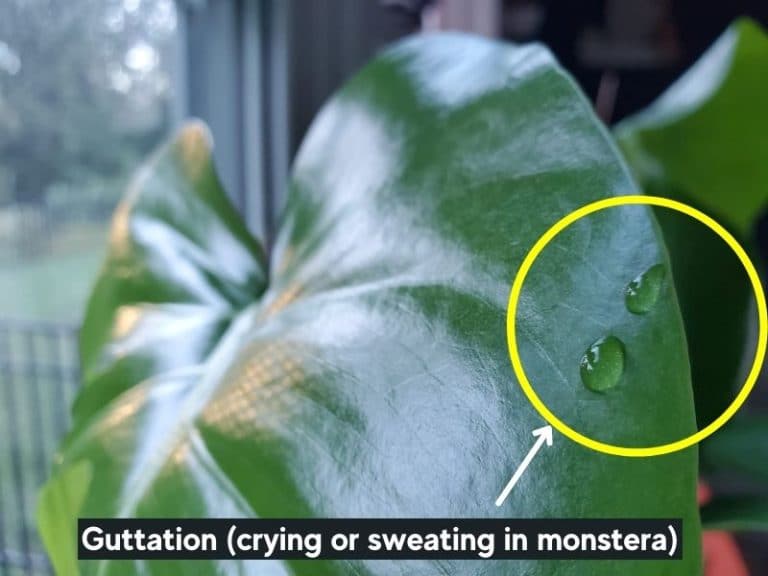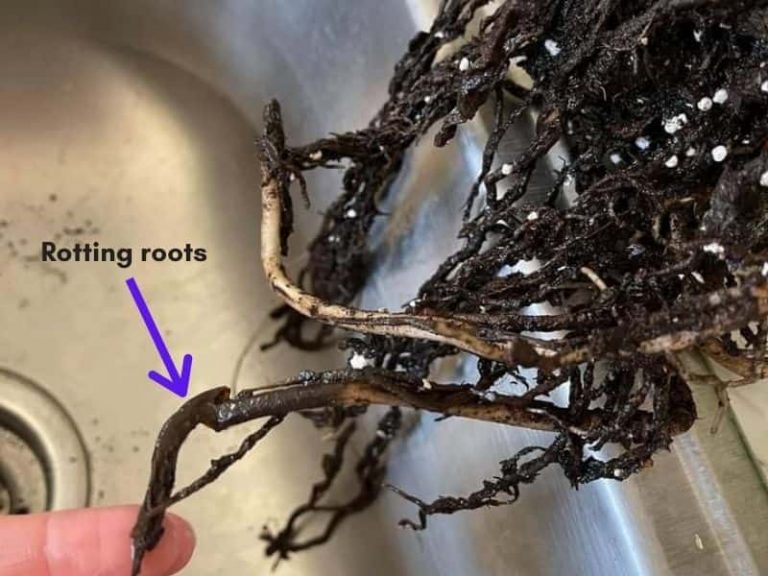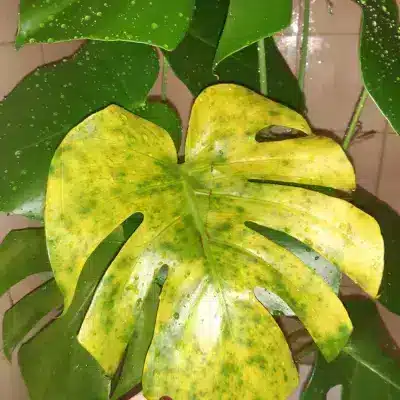Monstera Leaves Turning Yellow: 5 Fixes that Work
Monstera, also known as the Swiss cheese plant is susceptible to leaf yellowing when growing under stressful conditions. The yellowing may occur all over the leaves or on certain specific parts, depending on the cause.

The most common causes of monstera leaf yellowing are overwatering, improper light conditions, pest infestation, and root rot.
Why is my monstera turning yellow?
There are several reasons why monstera leaves turn yellow. These include poor light conditions, excessive soil moisture, low humidity, pest infestation, and fungal diseases.
Improper light conditions
Monstera is likely to suffer leaf yellowing under bright light conditions. And even though the plant can still grow in low-light conditions, the same may still occur under inadequate light exposure.
You can determine whether Swiss cheese leaf yellowing is being caused by insufficient light by observing the yellowing pattern. You’ll notice yellow patches or yellowing along the leaf veins, instead of yellowing on the whole leaf.
Overwatering
Monstera leaf yellowing may also be an early sign of root rot caused by overwatering. The problem may be caused by irrigating your monstera plant way too often or planting monstera in poor-draining soil that retains excess moisture.
Simply stick a finger into the soil to find out whether your Swiss cheese leaves are turning yellow due to excessive soil moisture.
Your monstera is likely overhydrated if it feels wet, soggy, and has a rotten/funky smell. Apart from leaf yellowing, an overwatered monstera plant may also appear droopy, with brown leaf spots.
Low humidity levels
Monstera plants are native to the tropics and thus prefer high-humidity conditions. If the local humidity levels fall below 60%, your monstera leaves will likely turn yellow. This is especially common for monstera plants growing indoors, as relative humidity levels are usually kept lower than that to make the home more comfortable.
Pest infestation
If your Swiss cheese leaves are spotting yellow patches, you’re most likely dealing with a pest infestation problem. Some of the most common pests that attach monstera include scaly insects, spider mites, mealybugs, and aphids.
- Scales- these tiny, brown insects suck the sap out of monstera foliage, causing them to turn yellow, while the plant exhibits stunted growth.
- Spider mites- These barely visible pests feed on the leaf juice on the underside of monstera leaves, excreting honeydew, which triggers leaf chlorosis/yellowing.
- Mealybugs- These white, crawling insects feed on monstera leaf sap, resulting in leaf yellowing.
- Aphids- just like spider mites, these pesky pests excrete honeydew on monstera leaves, inhibiting proper light absorption leading to leaf yellowing.
Fungal Diseases
Monstera plants are highly susceptible to a variety of fungal diseases, including fungus gnats, anthracnose, and powdery mildew. The larvae of fungus gnats are harbored in the soil and feed on monstera roots.
Once they cause significant root damage, the plant cannot adequately draw nutrients, oxygen, and water from the soil, causing leaf stress that leads to leaf yellowing and wilting.
Anthracnose is another soil-borne fungal disease that causes brown/black patches on monstera eaves, with a yellow halo around each of the patches. Meanwhile, powdery mildew only causes monstera leaf yellowing at the advanced stages of infection.
Root Rot
Root rot is more of a secondary cause of monstera leaf yellowing than a primary cause. If the soil in which your monstera grows is too compact or doesn’t drain well, the plant’s roots are likely to rot. Root rot will also occur if you water your monstera too frequently.
Excessively moist soil is usually oxygen-deficient, causing monstera plant roots to choke. As the roots slowly die out, the plant struggles to absorb nutrients, water, and oxygen, causing the leaves to turn yellow and wilt.
To determine if your monstera plant foliage is turning yellow due to root rot, remove the plant from the soil mix and inspect its roots. Rotten monstera roots are usually black, soggy, and have a decaying smell.
Heat Stress
Being tropical plants, monsteras are averse to extremely cold conditions. You’ll notice leaf yellowing on your monstera once temperatures drop below 50 degrees Fahrenheit. It’s, therefore, not advisable to place monstera next to cold, drafty windows during the cold season.
Extremely high temperatures above 85 degrees Fahrenheit will also cause monstera leaf yellowing. That’s why you should not expose your monstera plants to direct sunlight or hot radiators. Young, tender monstera leaves are usually more vulnerable to leaf yellowing caused by heat stress compared to the older leaves.
Transplant Shock
Leaf yellowing in Monstera may also occur after repotting the plant or transplanting it from a growing pot to your outdoor garden. That’s because the plant is experiencing repotting stress/transplant shock due to the sudden change in soil conditions or the roots being exposed for too long during repotting.
Your monstera will try to adjust or respond to the sudden changes by conserving water and nutrients, resulting in leaf yellowing. In the case of transplant shock, the oldest monstera leaves turn yellow first.
Note: Leaf yellowing due to transplanting or repotting is usually temporary and your monstera should appear normal again a few days post-transplanting.
Nutrient Deficiency
Though not common, your monstera leaves may also turn yellow if the plant isn’t getting enough nitrogen or potassium nutrients. Nitrogen deficiency triggers stunted growth and chlorosis, with the older leaves at the base of the plant turning yellow first.
Meanwhile, when there’s a potassium deficiency, your monstera plant will reroute the minimal potassium nutrients available to the younger foliage. As a result, the older leaves will turn yellow first.
Over-fertilization
Monstera plants thrive when there’s a balance of nutrients. As such, feeding them with too much fertilizer nutrients may also lead to leaf yellowing. As the excess nutrient salts build up in the soil, they draw water away from the monstera roots, a phenomenon referred to as reverse osmosis.
Over-fertilization can also cause ‘salt burn,’ as the excess nutrients change the soil’s acidity. You can tell that your monster; leaves are turning yellow due to over-fertilization if there’s a white fertilizer crust on top of the soil, if the plant is exhibiting stunted growth, or if the yellowing is more prominent within the older leaves at the base of the plant.
How to fix yellow Monstera leaves
To effectively treat monstera leaf yellowing and allow the plant to thrive again with green foliage, you need to first determine the cause of the issue. After finding out the cause, you can fix the leaf yellowing problem, as detailed below.
Provide Optimal Light Conditions
For leaf yellowing caused by low light conditions, we recommend installing artificial lighting to provide supplementary light. Meanwhile, if the problem is due to excessive light, move the plant away from direct sunlight. If your monstera lies on a window, consider installing window drapes to filter the sun’s rays.
Avoid Overwatering
For Monstera deliciosa leaves that are turning yellow due to excess soil moisture, you can fix the problem by slowing down your watering frequency to once a week. You should also allow the top two inches of the soil mix to fully dry up in between watering sessions.
Additionally, avoid watering your outdoor monstera plants during rainy weather. Finally, ensure proper drainage by transferring the monstera to a pot with drainage holes, filled with a well-draining soil mix.
Apply Pest Control Measures
If the leaf yellowing is due to pests like mealybugs and spider mites, apply mechanical controls such as washing the Swiss cheese leaves or pruning off infested leaves. We also recommend trying out natural insecticides such as horticultural oils.
Spray the Plant with Commercial Fungicides
If the problem is due to fungal diseases, consider applying a commercial fungicide to your monstera plants. When using chemical fungicides on garden plants, always follow the manufacturer’s guidelines to avoid causing damage to your desirable plants.
Leech out Excess Fertilizer Salts from the Soil
If the soil in which your Swiss cheese grows is over-laden with fertilizer salts and is causing leaf yellowing, consider leeching off the excess nutrient salts with water. This should be done repeatedly for maximum efficacy. Afterward, withhold fertilizer application until after the plant is fully recovered.
Should I cut the yellow monstera leaves?
You should only prune off yellow monstera leaves if the yellowing is due to fungal infection. Cutting off the affected leaves will prevent the disease from spreading to the rest of the leaves.
However, you should avoid pruning yellow leaves if the cause is root decay. That’s because the healthy monstera leaves draw nutrients from the dying leaves.
Can yellow monstera leaves turn green again?
Leaf yellowing is an irreversible process, so your yellow Swiss cheese leaves won’t turn green again. Prune off the yellow leaves and water and fertilize sparingly for new, green foliage to emerge.
Also, if the yellowing is only occurring in certain sections of the leaves, you can cut off the yellow parts on each affected leaf and leave behind the green parts.




